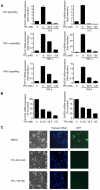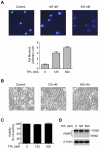Triptolide (TPL) inhibits global transcription by inducing proteasome-dependent degradation of RNA polymerase II (Pol II)
- PMID: 21931633
- PMCID: PMC3172214
- DOI: 10.1371/journal.pone.0023993
Triptolide (TPL) inhibits global transcription by inducing proteasome-dependent degradation of RNA polymerase II (Pol II)
Abstract
Triptolide (TPL), a key biologically active component of the Chinese medicinal herb Tripterygium wilfordii Hook. f., has potent anti-inflammation and anti-cancer activities. Its anti-proliferative and pro-apoptotic effects have been reported to be related to the inhibition of Nuclear Factor κB (NF-κB) and Nuclear Factor of Activated T-cells (NFAT) mediated transcription and suppression of HSP70 expression. The direct targets and precise mechanisms that are responsible for the gene expression inhibition, however, remain unknown. Here, we report that TPL inhibits global gene transcription by inducing proteasome-dependent degradation of the largest subunit of RNA polymerase II (Rpb1) in cancer cells. In the presence of proteosome inhibitor MG132, TPL treatment causes hyperphosphorylation of Rpb1 by activation of upstream protein kinases such as Positive Transcription Elongation Factor b (P-TEFb) in a time and dose dependent manner. Also, we observe that short time incubation of TPL with cancer cells induces DNA damage. In conclusion, we propose a new mechanism of how TPL works in killing cancer. TPL inhibits global transcription in cancer cells by induction of phosphorylation and subsequent proteasome-dependent degradation of Rpb1 resulting in global gene transcription, which may explain the high potency of TPL in killing cancer.
Conflict of interest statement
Figures





Similar articles
-
Triptolide Induces Cell Killing in Multidrug-Resistant Tumor Cells via CDK7/RPB1 Rather than XPB or p44.Mol Cancer Ther. 2016 Jul;15(7):1495-503. doi: 10.1158/1535-7163.MCT-15-0753. Epub 2016 Mar 29. Mol Cancer Ther. 2016. PMID: 27197304
-
Triptolide-induced transcriptional arrest is associated with changes in nuclear substructure.Cancer Res. 2008 Jul 1;68(13):5257-66. doi: 10.1158/0008-5472.CAN-07-6207. Cancer Res. 2008. PMID: 18593926 Free PMC article.
-
Natural product triptolide mediates cancer cell death by triggering CDK7-dependent degradation of RNA polymerase II.Cancer Res. 2012 Oct 15;72(20):5363-73. doi: 10.1158/0008-5472.CAN-12-1006. Epub 2012 Aug 27. Cancer Res. 2012. PMID: 22926559
-
Therapeutic applications and delivery systems for triptolide.Drug Deliv Transl Res. 2020 Dec;10(6):1584-1600. doi: 10.1007/s13346-020-00827-z. Drug Deliv Transl Res. 2020. PMID: 32789808 Review.
-
Immunosuppressive and anti-inflammatory mechanisms of triptolide, the principal active diterpenoid from the Chinese medicinal herb Tripterygium wilfordii Hook. f.Drugs R D. 2003;4(1):1-18. doi: 10.2165/00126839-200304010-00001. Drugs R D. 2003. PMID: 12568630 Review.
Cited by
-
Specific Inhibition of HIV Infection by the Action of Spironolactone in T Cells.J Virol. 2016 Nov 14;90(23):10972-10980. doi: 10.1128/JVI.01722-16. Print 2016 Dec 1. J Virol. 2016. PMID: 27681137 Free PMC article.
-
Antitumor mechanisms and future clinical applications of the natural product triptolide.Cancer Cell Int. 2024 Apr 27;24(1):150. doi: 10.1186/s12935-024-03336-y. Cancer Cell Int. 2024. PMID: 38678240 Free PMC article. Review.
-
APOBEC3B regulates R-loops and promotes transcription-associated mutagenesis in cancer.Nat Genet. 2023 Oct;55(10):1721-1734. doi: 10.1038/s41588-023-01504-w. Epub 2023 Sep 21. Nat Genet. 2023. PMID: 37735199 Free PMC article.
-
Redundant pathways for removal of defective RNA polymerase II complexes at a promoter-proximal pause checkpoint.Mol Cell. 2024 Dec 19;84(24):4790-4807.e11. doi: 10.1016/j.molcel.2024.10.012. Epub 2024 Nov 5. Mol Cell. 2024. PMID: 39504960
-
Live-cell imaging reveals the spatiotemporal organization of endogenous RNA polymerase II phosphorylation at a single gene.Nat Commun. 2021 May 26;12(1):3158. doi: 10.1038/s41467-021-23417-0. Nat Commun. 2021. PMID: 34039974 Free PMC article.
References
-
- Efferth T, Li PC, Konkimalla VS, Kaina B. From traditional Chinese medicine to rational cancer therapy. Trends Mol Med. 2007;13:353–361. - PubMed
-
- Bao X, Cui J, Wu Y, Han X, Gao C, et al. The roles of endogenous reactive oxygen species and nitric oxide in triptolide-induced apoptotic cell death in macrophages. J Mol Med. 2007;85:85–98. - PubMed
-
- Fidler JM, Li K, Chung C, Wei K, Ross JA, et al. PG490-88, a derivative of triptolide, causes tumor regression and sensitizes tumors to chemotherapy. Mol Cancer Ther. 2003;2:855–862. - PubMed
-
- Kiviharju TM, Lecane PS, Sellers RG, Peehl DM. Antiproliferative and proapoptotic activities of triptolide (PG490), a natural product entering clinical trials, on primary cultures of human prostatic epithelial cells. Clin Cancer Res. 2002;8:2666–2674. - PubMed
Publication types
MeSH terms
Substances
LinkOut - more resources
Full Text Sources
Other Literature Sources

